Saying that something is at infinity is a convenient way of saying that the distance involved is much, much greater than the focal length.
So when the object is placed in the focal plane of the lens/mirror it is convenient to say that the image is formed at infinity.
In fact, in theory, the image is actually in two places.
On a screen as a real inverted image a long way away from the lens and on the opposite side of the lens to the object.
A virtual upright image a long way away from the lens which can be seen by looking through the lens at the object.
How can one infer all this?
By having the object close to the focal plane but remote from the lens and observing the image formed on a screen as being real, inverted and magnified.
Then moving the object closer and closer to the focal plane, seeing what happens and then imagining what would happen if the object was in the focal plane.
In the end all of this is theoretical because real lenses have defects and your analysis has dealt with ideal situations.
Any discussion of concave/convex mirrors needs to begin with a statement of the particular version of the mirror equation to be used, along with the convention for setting and interpreting the signs of focal lengths, and object/image positions.
For example, from http://scienceworld.wolfram.com/physics/MirrorFormula.html:


Unmentioned in this is the convention that virtual images and objects are found behind the mirror and have negative values of $d$.
In the particular example you present, the image formed by the primary mirror is a real image. If you put infinity for the object distance and a positive focal length, you find a positive image distance.
But when you insert a convex mirror, with a negative focal length, into the optical path, you must also consider the position of the real image (now an object) relative to the convex mirror. The object is behind the convex mirror; it is a virtual object, and its distance from the convex mirror is negative.
With appropriate positioning of the convex mirror, the formula will produce a positive value for the image distance. There will be real image formed in front of the convex mirror.
You've just designed a Cassegrain telescope...
Best Answer
If you align your viewing direction parallel to some set of parallel lines, you will visually see them ending at some "point" at infinite distance. The typical example is railroad tracks.
If you take lines that are not parallel, then no matter what perspective you take, the visual point of intersection (if there is one) will always be a finite distance away, and thus not at infinity. E.g. the pole in the image is skew to the rails of the track, so no matter how you orient your view they will never appear to intersect at all, whether at infinity or not. Or take the rails and the wooden rail ties. They make right angles at points in real space, and no matter how you orient yourself you can never make them appear to intersect anywhere but at those points. Non-parallel lines are defined not to meet at infinity because our vision tells us they don't meet at infinity.
Also note that there are different points at infinity. The point at infinity at which the railroad tracks intersect is visually different from the one at which all the vertical lines in this photo intersect. And both are different from the one at which the horizontal wooden ties intersect. This is in disagreement with @nu's answer. This is because there are many ways to mathematically construct points at infinity given a suitable definition of "real space". My definition corresponds to projective space, instead of a one-point compactification.
The usage of many different points at infinity is justified by our visual intuition, and also by optical intuition. E.g. we usually idealize stars as point sources at infinity. But there are many stars that visually appear at different places in the sky. This is hard to make sense of if there is only one point at infinity, but if you instead construct many points at infinity, each star can get its own. Similarly, if you have a beam of parallel light rays and stick your eye in the beam, you will see the light as a "star" at the one point at infinity at which the parallel rays intersect, and not at a different point at infinity. If the rays instead intersect at some finite point, you will see a light source at that point, and not at any point at infinity.